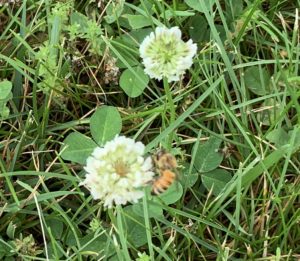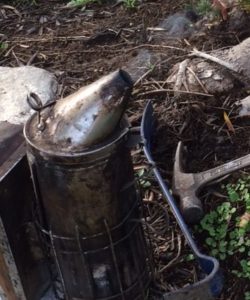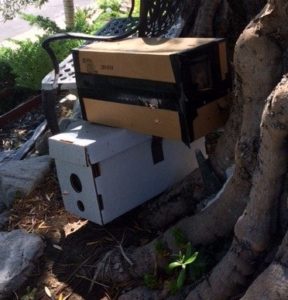Hello, fellow lover of all things green,


Pollinators sharing a single crocus.
While walking Jolee this morning, I admired crocuses on the side of the road. A white one sits solo with purple lines on the petals, almost like runways, leading pollinators to the yellow puffy pollen. I stood above it, watching the dance of two honeybees, and marveled how they worked around each other in the tiny space, sharing the bounty. It makes me think of my college roommate’s dilemma, who lives in Mission Viejo, California, resulting in relocating honeybees with surprises.
Linda’s first colony of honeybees inundated their sixty-year-old olive tree in February 2017. I remember during a visit convincing her the tree, though technically too close to the front door, should remain. Mr. Olive has such character, with multiple gnarly trunks bursting into a dense green canopy, offering a shady seating spot below. But with all the bee activity, there’s no sitting under the tree. More problematic is their dog Sugar had a near-death experience when she was stung.
How Bee Location Companies Work
In the spirit of saving the crucial pollinators rather than using pesticides, Linda sought out a bee relocation company. They closed the tree openings and installed a metal mesh cone that allowed the bees to exit the hive but not re-enter. Pheromones enticed the bees to enter a temporary box hive below the tree.
Four months later, the bees were still there. The first box of pheromones didn’t attract them, and it turns out Linda’s honeybees “acted oddly,” according to Dan, the bee man of We Save Bees, who never saw anything like it. After seven visits to seal up entries, the bees managed to find a way into their hive by digging in the ground each time.
Linda described the bubble of bees working and the “bee pile of the lazy buggers who opted out of the dig.” There’s a subterranean hive in the underground caverns around the roots. At last, they managed to plug up all the entries, and an estimated 50,000 honeybees were relocated to Temecula, CA, to work on a farm.
“I enjoyed my bee experience and will miss the little guys,” wrote Linda, who added, “Were it not for Sugar, I would have set up a hive and officially become a beekeeper!”
A new colony of honeybees
Seven years later, Linda has another colony of honeybees in her beloved olive tree. I spoke with her today to get the skinny. It turns out that the remedy of filling the entries from the first hive failed as the tree grew, and the cavity became accessible again.

Interestingly, there isn’t a demand for honeybees in Southern California now. The bee man said more rain than usual in the last two winters has encouraged bee migration from the desert areas. So rather than gathering the honeybees to move them, they smoked them out and then stuffed the cavity with steel wool, a temporary fix. Linda will have to hire another company to install a permanent way to block the entries.
Can there ever be too many bees?
Isn’t it remarkable that there are enough honeybees now, even a surplus in Southern California? What was once sought out is considered a pest to some. Yet there’s a decline in honeybees and other essential pollinators elsewhere.
Maybe we shouldn’t judge beneficial bees versus pests. Perhaps we should let them be rather than modify environments by irrigating deserts to have lawns. Not to say we can have 50,000 honeybees right outside our front door, but here are kind ways to move them along. Thank you, Linda, for doing just that.
How you can protect our pollinators
We can all do our part to protect pollinators by planting plants with a sequence of blooms so nectar and pollen are available throughout the growing season. Include plants like dill, fennel, and milkweed on which butterfly larvae feed. And provide a water source such as a fountain or birdbath.
Lay off the chemicals, even organic ones, as they also can be toxic to insects. However, an organic approach is safer applied when pollinators are inactive in the early morning or late evening.
Let part of your lawn or a hedgerow grow wild to provide shelter. Leave a dead tree standing or lying, creating nooks for butterflies and solitary bees. Most of all, be grateful for nature’s magnificence. We are all part of the cycle and share this world with wildlife. Be Kind.
Garden Dilemmas? AskMaryStone@gmail.com and your favorite Podcast App.
There’s more to the story in the Garden Dilemmas Podcast (a soothing 10 minutes):
Need to relocate a honeybee hive? Your local Beekeepers Association can guide you in finding bee relocating providers, many of whom are beekeepers themselves. Many don’t charge for their service. However, they advise after the bee removal, there are often repairs the homeowner will have to make. Linda paid a modest $325, well worth the good deed to save the honeybees.
Link to Beekeeping Associations In North America

Smoke from native wood is used to calm the bees. A temporary Box Hive with pheromones was set below the tree to entice the bees to enter.

Openings were filled with insulation and sealed with plaster. The cone installed allows bees to exit but not re-enter. They’ll permanently seal the openings once all the bees have vacated the tree.

Once no stragglers are left behind, they’ll move the temporary Box Hive with about 50,000 honeybees. Thank you, Linda, for sharing the story and saving the bees!
Click through to learn more about how we can do our part to help our pollinators—How can it Be?




Another great episode. I used to work at a pick your own apple orchard. In the spring, when it was time, a couple of tractor trailers full of bees would arrive. They were let go and would pollinate the entire orchard. (We had 22,000 apple trees). Your column brought back many pleasant memories. Thank you and please keep them coming.
How interesting that the orchard brought bees in. I wonder where they went after their job was done? Thank you for your kindness and support. :^)
Bee-utiful story.
Lucky Linda, having two bee invasions…
Hoping locusts aren’t next!
Lucky bees to have chosen the residence of your kind-hearted sister. Thanks for reading :^), Mary